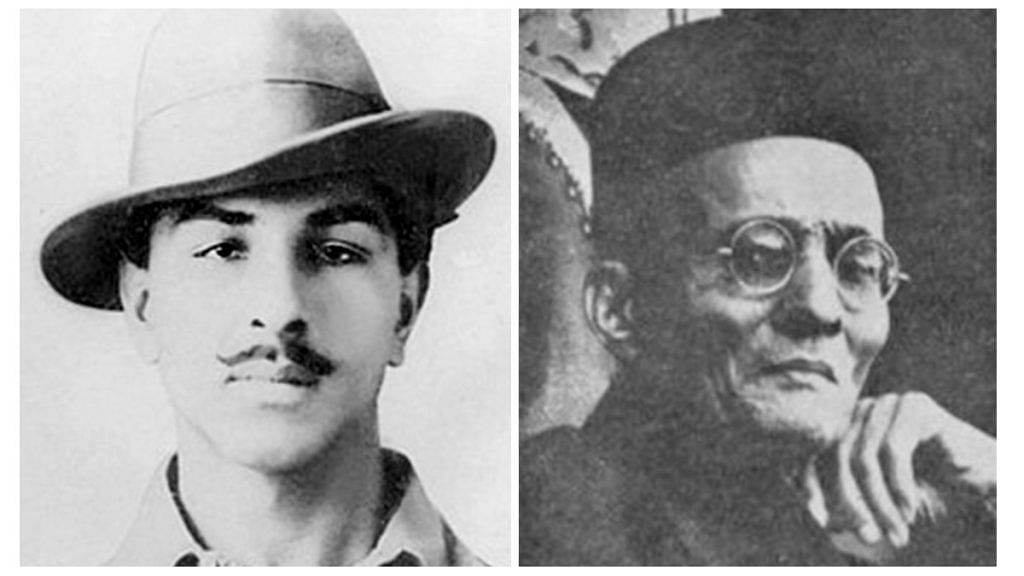New Delhi: Bhagat Singh and Vinayak Damodar Savarkar, two of India’s most well-known and still-relevant freedom fighters, had immense respect for each other, rooted in the cause of the freedom struggle.
Singh considered Savarkar, popularly known as Veer Savarkar, as a “braveheart”, according to historical records.
The revolutionary, himself an icon to generations, wrote about Savarkar — who gave birth to the Hindu nationalist philosophy of Hindutva — on multiple occasions, including after the latter’s incarceration in Andaman’s Cellular Jail, infamously called Kala Paani.
Savarkar too showed deep grief when the British government hanged Singh along with Rajguru and Sukhdev on 23 March 1931.
Also read: Gwalior to Godse — Was Sardar Patel soft on Savarkar in Gandhi murder case, and if so, why
‘Braveheart’ Veer Savarkar
In two issues on 15 and 22 November 1924, Matwala, a patriotic Hindi weekly which used to be published from Calcutta, carried an article titled “Vishwa Prem”. The article praised Veer Savarkar and countered his critics.
“The one who loves this world is that braveheart, whom we don’t feel ashamed to call as a fierce insurgent and a fanatic anarchist — this is the Veer (brave) Savarkar,” the article said.
While the article was credited to ‘Balwant Singh’ (pseudonym), it was written by Bhagat Singh, according to Bhagat Singh Aur Unke Sathiyon Ke Sampoorna Uplabhda Dastawez (Complete available documents of Bhagat Singh and his fellow revolutionaries, 2019, Rahul Foundation, page 93).
When Singh wrote this article, Savarkar was under house arrest in Ratnagiri in Maharashtra. He was prohibited from participating in any political activity as a pre-condition of his release from Cellular Jail.
Many critics of him questioned him for accepting release on this condition. Political questions are raised on this subject even now.
However, Singh’s words in that period clearly show that the revolutionaries understood Savarkar’s tactical decision to accept this condition of the British government so that he could come out of the prison to continue his participation in India’s freedom struggle instead of languishing in a far away prison.
Also read: Godse, raised as a girl, saw Gandhi as an ‘effeminate’ Father who didn’t protect Mother India
‘What would cowardly people know…’
In August 1928, Bhagat Singh published an article in Keerti, another well-known publication of revolutionaries, as part of a series by him on the lives of various Indian revolutionaries. The series was meant to give readers an understanding of how the freedom struggle against the British was shaped and evolved especially in Punjab.
Titled Azadi Ki Shahadtein (sacrifices on the altar of freedom), the series was published from March to October 1928.
While writing about revolutionary Madan Lal Dhingra, who shot dead Curzon Wyllie in England, Singh wrote in detail about how Savarkar had set up ‘India House’, which became the hub of Indian revolutionaries, and how Savarkar inspired Dhingra to go ahead on his mission fearlessly.
Explaining the emotional moment when Dhingra and Savarkar finally decided about the assassination of Wyllie, Singh wrote, “The two hugged each other. They were in tears. How invaluable and indelible that teardrop was. What would the cowardly people know about that emotion of those who aren’t afraid of death, how would the cowards know that how holy, how revered, how high are the people who sacrifice their lives for the nation.” (Bhagat Singh Aur Unke Sathiyon Ke Sampoorna Uplabhda Dastawez, page 166-168.)
Noted historian Y.D. Phadke in his works on Savarkar published in Marathi (Shodh Savarkrancha, Shrividya Prakashan, Pune) said Singh got the English translation of Savarkar’s work on the 1857 war of independence which was originally published as ‘1857 Ka Swatantrya Samar’ and published an edition of it.
While the first edition was published by revolutionary Lala Hardayal, Singh published the second one and Netaji Subhas Chandra Bose took out the third.
The book is considered to be one of the most influential works of the time, which not only challenged the British narrative of running down events in 1857 as a “revolt” but also inspired scores of revolutionaries to fight against the British tyranny.
In his ‘Jail Diary’, Singh has also quoted from Savarkar’s work on Hindu nationalism titled ‘Hindupadpaadshahi’ (The Hindu Empire). While quoting Hindupadpaadshahi, Singh wrote, “One can get rid of the political subjugation anytime but it is difficult to break away from the clutches of cultural slavery.” He used several other quotes from the book.
Bhagwati Charan Vora and other fellow revolutionaries of Singh have also mentioned in several places about how Savarkar’s revolutionary activities and writings had a deep influence on several revolutionaries, including Singh. These writings can be found in Bhagat Singh Aur Unke Sathiyon Ke Sampoorna Uplabhda Dastawez.
Savarkar on Bhagat Singh
After Bhagat Singh, Rajguru and Sukhdev were hanged in Lahore, Savarkar penned a poem for them mourning their death and bowing to their valour and courage, according to Phadke.
On the day when these three revolutionaries martyred, the saffron flag on top of Savarkar’s house at Ratnagiri was replaced by a black flag.
The writer is research director with Delhi-based think-tank Vichar Vinimay Kendra. He has written two books on RSS. Views expressed are personal.
Also read: There’s a lobby that wants to keep Nathuram Godse alive. And it’s not the Hindu Right
